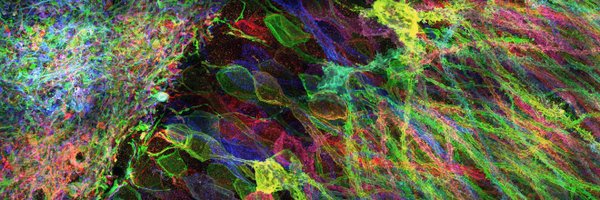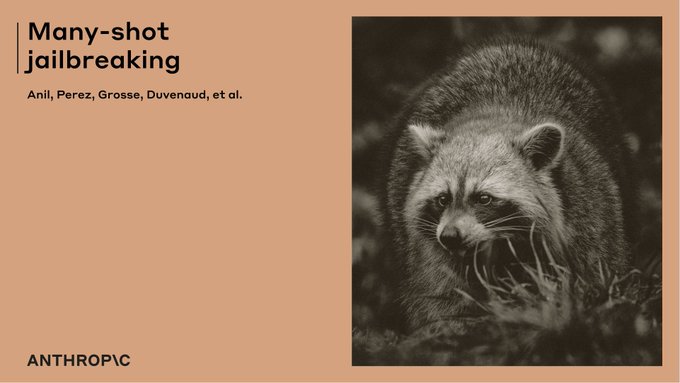
Cem Anil
@cem__anil
Followers
2,041
Following
1,389
Media
15
Statuses
469
Machine learning / AI Safety at @AnthropicAI and University of Toronto / Vector Institute. Prev. student researcher @google (Blueshift Team) and @nvidia .
Toronto, Ontario
Joined November 2018
Don't wanna be here?
Send us removal request.
Explore trending content on Musk Viewer
America
• 1075191 Tweets
Happy 4th
• 875103 Tweets
Labour
• 610827 Tweets
Independence Day
• 523748 Tweets
Reform
• 488385 Tweets
Tories
• 290903 Tweets
#loveIsland
• 217427 Tweets
Tory
• 203913 Tweets
Keir Starmer
• 130811 Tweets
#GeneralElection2024
• 119826 Tweets
Mimi
• 109754 Tweets
Sean
• 103380 Tweets
Mario Delgado
• 74126 Tweets
Maya
• 61849 Tweets
Corbyn
• 54858 Tweets
#TemptationIsland
• 40370 Tweets
Sky News
• 32759 Tweets
Raul
• 32740 Tweets
Andy Murray
• 31305 Tweets
Channel 4
• 26233 Tweets
Luca
• 25227 Tweets
Lib Dems
• 23625 Tweets
Reino Unido
• 20009 Tweets
Matilda
• 18184 Tweets
THE ARCHER
• 15275 Tweets
#ExitPoll
• 12984 Tweets
Joey Chestnut
• 10571 Tweets
GUILTY AS SIN
• 10144 Tweets
Last Seen Profiles
Pinned Tweet
AIs of tomorrow will spend much more of their compute on adapting and learning during deployment.
Our first foray into quantitatively studying and forecasting risks from this trend looks at new jailbreaks arising from long contexts.
Link:
3
7
61
One of our most crisp findings was that in-context learning usually follows simple power laws as a function of number of demonstrations.
We were surprised we didn’t find this stated explicitly in the literature.
Soliciting pointers: have we missed anything?
7
6
69
How about few-shot scratchpad, a combo behind many strong LLM results? (eg. our recent
#Minerva
)
This leads to **substantial improvements in length generalization!**
In-context learning enables variable length pattern matching, producing solutions of correct lengths.
5/
1
0
15
Highly recommended!
Spending time at Google Blueshift feels like taking a sneak peek into what the AI scene will look like a few years ahead.
Best part, of course, is working closely with a fantastic team!
@bneyshabur
@Yuhu_ai_
@guygr
@ethansdyer
1
0
13
Relatedly,
@dwarkesh_sp
asks prescient questions about risks from test-time compute in his latest podcast with
@TrentonBricken
and
@_sholtodouglas
.
It’s a fantastic episode, give it a listen!
1
2
10
This was a fantastic collaboration with my amazing co-authors Ashwini Pokle*
@ashwini1024
, Kaiqu Liang*
@kevin_lkq
, Johannes Treutlein
@JohannesTreutle
, Yuhuai (Tony) Wu
@Yuhu_ai_
, Shaojie Bai
@shaojieb
, Zico Kolter
@zicokolter
and Roger Grosse
@RogerGrosse
.
1
0
6
There’s way more in the paper — check it out if you’re interested!
paper: []()
Also come say hi at
@neurips
!
1
0
6
See paper for more - especially our detailed analyses regarding the failure modes of finetuning.
Joint work with my fantastic collaborators
@Yuhu_ai_
, Anders,
@alewkowycz
,
@vedantmisra
,
@vinayramasesh
,
@AmbroseSlone
,
@guygr
,
@ethansdyer
and
@bneyshabur
.
8/
1
0
6
@CFGeek
Thanks!
We’re aware of this kind of scaling law for token-wise losses. The first author of the paper you linked paper is a co-author in ours :)
I should have said few/many shot learning in my tweet above, which has a shared but different problem structure.
2
0
4
@CFGeek
Here’s another paper that we cite that observes a similar token-wise power law trend under the pretraining distribution:
0
0
3
@AnimaAnandkumar
@neurips
Thank you for your comment!
That learning only given one-step evolution data is enough to predict long-horizon behaviour of chaotic systems is very surprising.
Your dissipativity regularizer seems very useful for us as well. Thanks again for the pointer!
0
0
2
@CFGeek
Agreed! Seems quite interesting.
Another similar idea:
Let’s say the function vectors are largely responsible for few-shot learning on simple tasks.
There are not that many attention heads that implement the function vector mechanism afaik. ⬇️
1
0
2
Very interesting work!
New work out on arXiv! Reverse engineering recurrent networks for sentiment classification reveals line attractor dynamics (), with fantastic co-authors
@ItsNeuronal
,
@MattGolub_Neuro
,
@SuryaGanguli
and
@SussilloDavid
.
#tweetprint
summary below! 👇🏾 (1/4)
3
52
201
0
0
1
@CFGeek
There is a huge overlap between these for sure.
I think the structure and data distribution differ enough that results on one might not generalize readily to the other.
E.g. the task vector mechanism seems fairly specific to few/many shot learning.
1
0
1
@CFGeek
Say we deleted these and only these heads from the network.
1) Do we still get token-wise loss scaling laws under pretraining distr? If so, did the exponent change?
2) Do we still get few-shot learning scaling laws? If so, did the exponent change?
0
0
1
@agarwl_
@hu_yifei
@arankomatsuzaki
Great work, congrats!
Loads of interesting new/complementary findings in there, definitely worth a detailed read.
DM me about Claude research access, will check what’s possible :)
0
0
1
@saakethmm
The num of padding tokens on left/right is indeed random (total num of tokens is fixed) — to train all position embeddings even on short instances.
We add the same num of padding tokens on both the input and scratchpad to keep the distance between the input and scratchpad fixed.
0
0
1

















































